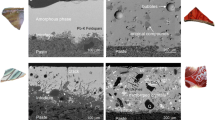Abstract
Ancient turquoise Persian glazed ceramics, which are well known as Khar-Mohreh, belonged to several centuries ago. In this research, reproduction of ancient glazed bodies was performed, and the products were studied by different techniques. Experimental evaluations were focused on elemental, structural, morphological, and colorimetric characteristics. SEM micrographs illustrated a thin (10 μm) uniform composite glazed layer on a porous composite thicker layer (500 μm). The layers consist of microneedle-shaped and nanospherical particles of copper oxide distributed in an amorphous silicate medium. Modeling of this architecture was used for determination of the visual aspect of the ceramic via the reflectance coefficient. Structural and colorimetric results showed that the shape and distribution of copper oxide particles do not play a crucial role on the color of these ceramics.









Similar content being viewed by others
References
H.E. Wulff, H.S. Wulff, L. Koch, Archeology 21, 98–107 (1968)
C. Kiefer, A. Allibert, Archaeology 24, 107–117 (1971)
F.D. Friedman, G.M. Leveque (eds.), Gifts of the Nile-ancient Egyptian faience (Thames and Hudson, London, 1998), pp. 177–194
M.S. Tite, M. Bimson, Archaeometry 28, 69–78 (1986)
M.S. Tite, I.C. Freestone, M. Birnson, Archaeometry 25, 17–27 (1983)
P. Vandiver, Technological change in Egyptian faience, In: J.S. Olin, A.D. Franklin (eds.) Archaeological ceramics, (Smithsonian Institution Press, Washington), pp. 167–179 (1982)
P. Vandiver, The manufacture of faience, In: A. Kaczmarczyk, R.C.M. Hedges (eds.) Ancient Egyptian faience: An analytical survey of Egyptian faience from predynastic to Roman times, (Aris and Phillips, Warminster, England), pp. Al–144 (1983)
M. Matin, M. Matin, J. Archaeological Sci. 39, 763–776 (2012)
S. La Delfa, V. Formisano, E. Ciliberto, J. Cult Heritage 9, e113–e116 (2008)
S. Sen, Ceramic whitewares: their technologies and applications (Oxford & IBH Publishing Co. Pvt, Ltd. India), pp. 157–158 (1993)
M. Born, E. Wolf, Principles of optics: electromagnetic theory of propagation, interference and diffraction of light, 7th edn. (Cambridge University Press, UK, 2002)
G. Mie, Ann. Phys. 25, 377–455 (1908)
E.S. Thiele, R.H. French, J. Am. Ceram. Soc. 81, 469–479 (1998)
M.D. Lechner, J. Serb. Chem. Soc. 70, 361–369 (2005)
S. Berthier, Optique des Milieux Composites (Polytechnica, Paris, 1993)
J.C.M. Garnett, Phil. Trans. R. Soc. London A 205, 237–288 (1906)
V.F. Drobny, D.L. Pulfrey, Thin Solid Films 61, 89–98 (1979)
U. Kreibig, M. Vollmer, Optical Properties of Metal Clusters (Springer, Berlin, 1995)
Acknowledgments
The authors would like to thank Mr. Saadatmand, president of Khar-Mohreh workshop in Qom, for his encouragement and support during this work. In addition, they appreciate Dr. A. M. Arabi for his kindly comments.
Author information
Authors and Affiliations
Corresponding author
Rights and permissions
About this article
Cite this article
Mesbahinia, A., Rashidi-Huyeh, M. & Shafiee Afarani, M. Persian turquoise glazed bodies: reproduction and optical properties. Appl. Phys. A 118, 1183–1188 (2015). https://doi.org/10.1007/s00339-014-8857-6
Received:
Accepted:
Published:
Issue Date:
DOI: https://doi.org/10.1007/s00339-014-8857-6




